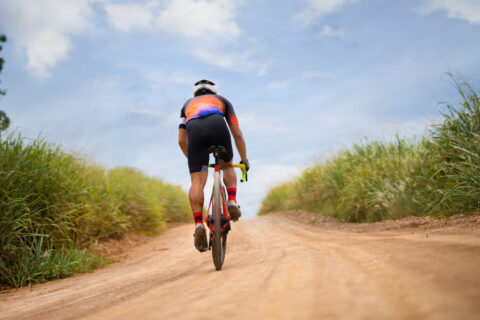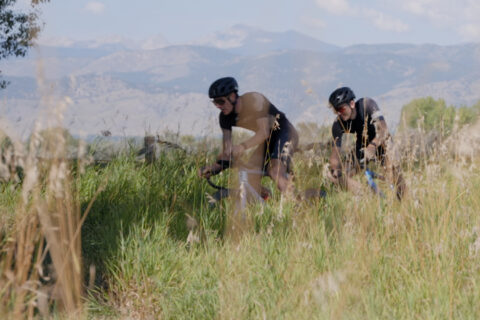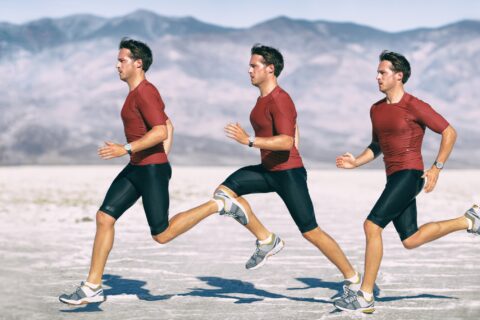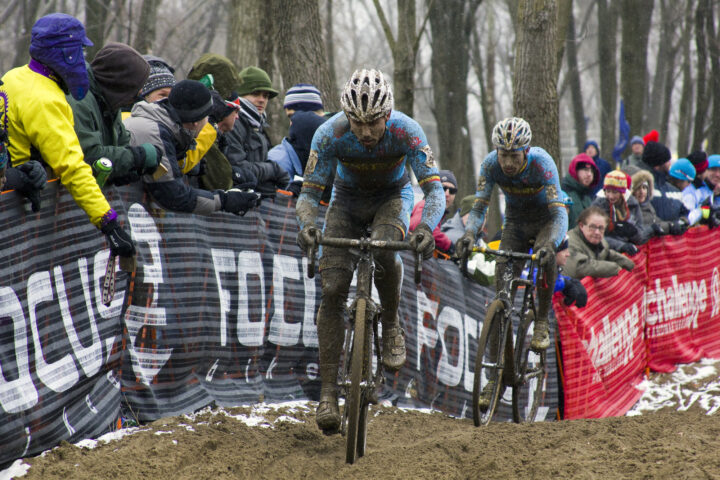Grant Holicky, cyclocross coach, dissects key techniques for an explosive race start, seamless mounting and dismounting, and air-tight cornering.
Video Transcript
Grant Holicky 00:03
Hey everybody, I’m Grant Holicky, from Forever Endurance, and The Blue Stages Racing Cyclocross Team. Today I’m representing Fast Talk Laboratories, and we’re going to talk a little bit about cyclocross. The goal today is to give you some insight and give you some tips regarding some of the main skills that come about in cyclocross so that we can get through those skills a little less anxiety, a little less stress, and a lot less energy, so we can use that energy later in the race to really push on the pedals.
Positioning of the Rider at the Cyclocross Start
Grant Holicky 00:33
What we’re going to start with is some of the specifics of the positioning of the rider when we’re doing the cyclocross start. Some riders start off the saddle, but we mostly encourage our riders to start in the saddle. The main reason that’s helpful is it allows for a quicker clip-in of the non-drive foot. So, whether you start right foot in the pedal or left foot in the pedal when you’re down on the saddle, you’re more in your regular pedaling position, so as that second foot comes over, it’s going to find that pedal more naturally, and a little bit easier. So, that’s why we’re going to encourage you to start in the saddle when you do this start.
Crank Position
Grant Holicky 01:12
The second thing we’re going to talk about here is we’re going to talk about the crank position. We want this crank position a little bit higher than parallel to the ground, what we’re looking for is that we can immediately drive lots of power into that pedal and get as much of that power section through the stroke as we can, as we’re initiating this start, this is going to give us as much momentum as possible to help with that second clip in and drive us forward through the start.
Gearing
Grant Holicky 01:44
The last thing that we’re going to look at here is gearing, and what we’re going to do on the start line. One of the things we see a lot of riders do is they’re over-geared at the start. So, they’re in a big strong gear because it allows you to feel like you’re delivering lots of power to the pedals, while that may be true, the real driving force behind a cyclocross start is torque. So, we want to be in a small gear, that’s going to allow us to move that pedal faster, move that gear faster, and drive the torque way up. This is going to increase power quickly, and we’re going to be at a nice high power immediately off the line. So, when the horn goes off, or the whistle goes off, or somebody yells go, however, your cyclocross start begins, you want to be in a place where you are 100%, ready to go immediately. So, what we’re looking for is the reaction, we don’t want the brain to have to think, we don’t want you to have to say, “Okay, now go.” So, the couple things that we want to do as a rider to be ready to do that.
Hands on the Hoods and off the Brakes
Grant Holicky 02:44
So, first things first is your start position with your body, you’ll see somebody like Lars Van der Haar get very low, that’s his start position, other people just want to be relaxed. One of the things we’re going to talk about here is to get the hands-on hoods and off the brakes. If you’re holding the brakes and gripping hard when that horn goes off, the first thing you’re going to think about doing, release the brakes, then think about sprinting. So, we want this position completely ready, the horn goes off or the whistle blows, and immediately we’re driving power into that pedal to explode off the line as quickly as we possibly can. So, one of the main things we want to think about when we’re doing a cyclocross start is making sure that our gearing remains correct through the start. So, as they come off the line, they’re in that small gear, which is going to allow for a nice high cadence, and as they go through that start, you’re going to hear those shifts so that they remain in high cadence all the way through the start stretch, to keep that explosive power and to keep the speed nice and high.
Mounts and Dismounts
Grant Holicky 03:50
One of the main pieces of cyclocross racing is going to be mounts and dismounts, getting off the bike and getting back on, there’s a lot of videos and a lot of instructional things out there on how to do this skill very, very well. We hope to give you a little bit more additional insight and some little things that are really going to take your game to the next level. So, one of the big things we’re going to always talk about anytime we’re talking about dismounts, this retention of momentum, retention of momentum is a huge key for cyclocross in general. As you’re coming into the barriers, or into any mount at all, we want to prepare by making sure our hands are relaxed on the hoods, we’re in a great spot, the body’s relaxed, that way, you’re going to be able to absorb any of those bumps that come in as you’re approaching the barriers. Now, you want to dismount as close to the obstacle as possible, that’s going to allow you to retain the most momentum going into that obstacle. So, as you start to dismount, that rear leg is going to come across, we want to move quickly so that it’s not a big pause coming into those barriers, that’s going to take more time, move that leg quickly, step off the bike, and you’re going to lift to bring that bike up over the barriers, as you’re moving through. You’ll notice two different methods with Chris and Eric, Chris does not grab the top two before he’s off the bike, he’s off the bike then reaches down and grabs the top tube on the left, Eric’s going to have that hand on the top tube as he’s dismounting the bike, it’s just going to allow him to lift that bike a little bit quicker, and cleaner going over the barriers. Once we dismounted the bike, there are a couple of things that we can do to help us get through those barriers with a little bit less energy, give me that bike. So, what you’re going to do is as you dismount the bike, you’re going to be in this position, hand on the top tube, other hands on the bike, as you come into that first barrier, if those barriers are full height, you got to do a big lift to get that bike up and out. A little trick that we can do in your suitcase is done a little wrist twist, and lift that bike wheels out, and what that’s gonna do is a little less energy, get the bike to clear the barriers, it can relax between the barriers, place that bike down as you come off and out of the barriers. As you come out of the barriers with that bike, we want to think about a couple of things that are going to make that transition smoother. The first thing we’re going to do is make sure that we’re setting the bike down on the ground, we don’t want to drop the bike down on the ground and risk a chance the chain may move, or the gearing may be screwed up so that when we get back on the bike, we’re crunching through the gears, and that’s slowing our process of getting back to accelerating. So, as we go to mount that bike, we’re going to place it down, hopefully, we prepped our gears while going into it, so we’re not over-geared coming out of the obstacle, we’re going to launch up onto the saddle aiming the land, I tend to think of trying to land on that upper thigh area, get settled into the saddle the feed into the pedals as quickly as possible and get moving.
Technique and Cornering
Grant Holicky 06:54
Another element of cyclocross that we’re going to spend some time on today, is the technique and what we want to be focused on when we’re cornering. So, as somebody is coming into that corner, a couple of things that we always want to do, we want to prep our gears, and this way, we know the course, we’re prepping our gear so that when we come out of that corner, we’re not over-geared, we’re not mashing the pedals. Additionally, as we come into that turn, want to regulate our speed, we want to make sure that we’re never in a point that we’re in the apex of the turn, cranking on the brakes, what that’s going to do is slow us down, and now we have to overcome inertia as we start to accelerate back out of that turn. As we’ve talked about before, in cyclocross momentum is everything. So, we want to do everything we can to retain that momentum coming into the corner. Now, for the actual technique of cornering, what we’re going to concentrate on and make sure we’re doing is the weight is going to be on our hands and pressured down through the front tire into the terrain that we’re cornering on. It’s typical on a mountain bike, it’s easy to lean back or get up off the saddle, keeping that weight particularly on the inside hand and counter-steering through that corner, what we’re going to do is weigh the front tire, trust that tire tread driving into the terrain, and by driving it, that tire is going to flatten out, the train is going to accept the tread, and we’re going to get that grip we need to deliver momentum and speed through the corner and accelerate out. You can see them as they come into this corner, the speed is managed and making sure they are not even grabbing the brakes at all, as they come through that, Chris is grabbing them a little bit, as we watch Eric, he’s off the brakes through this corner, weighting that front tire and that wheel, and he’s accelerating out because the gear is set up correctly, he could just jump on it. Here we go, weigh that tire, and accelerate out of the corner.
Different Terrain
Grant Holicky 08:47
Different terrain is going to require different techniques when we’re cornering on the cyclocross bike. Here we’re looking at some loose gravel, more of a dry condition, what we’re going to do is going to be a little bit less aggressive in that corner than we can be on grass. So, instead of driving and tilting the whole bike and pressing that whole bike into the corner, we’re going to leave the bike a little bit more upright, bend the body towards the inside, that’s going to protect that front wheel from a washout and put us in a position where we can recover by unclipping, to recover if that washout starts to happen. Now, as they’re coming into this corner, you’re gonna watch a little bit less speed, Chris is choosing to use the outrigger, gets that foot out into a position where he’s going to be protected on the bike, that bike is a bit more upright in that corner, we’re not getting ourselves susceptible to that front wheel sliding out from under us and going down. So, we’re in a position where we’re always in control of that bike, and we’re also always in a place where we’re going to be able to recover quickly if something does go wrong.
Grant Holicky 09:51
Thanks for tuning in this week, hopefully, you got a little bit out of some of our tips and the things that we’re talking about to make you just a little bit faster on that cyclocross course. Remember, if you can get a half-second or a second, out of every feature on that lap, it’s gonna add up to a lot of time per lap and a lot of time over the course of the race. We’re really excited here at Fast Talk Laboratories to be bringing you more episodes on ways to really clean up and get better at cyclocross. We hope that you’ll join us for those down the road.



